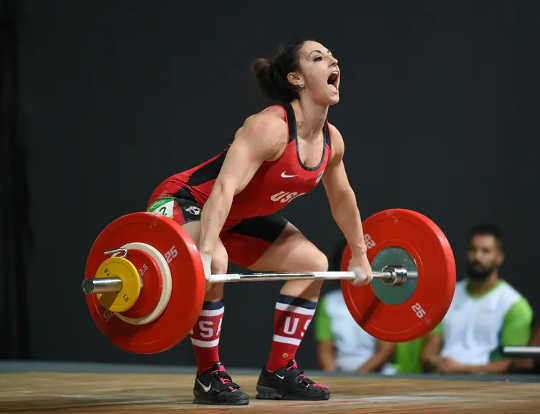
The menstrual cycle and the pill may have the greatest impact on elite athletes. Leonard Zhukovsky/ Shutterstock
The menstrual cycle, the pill and their potential impact on sporting performance have long been considered a taboo subject. Yet for most females who undertake any form of exercise or high-performance sport, there are a range of challenges that can affect their athletic performance, including from their menstrual cycle and their use of contraceptive pills.
But a historic lack of scientific research in these areas still means we have very limited knowledge of the specific effect that both have on athletic performance. However, what research we do have on these subjects shows both can have an impact on athletic performance – which may be especially important for elite athletes.
During the average menstrual cycle, levels of the sex hormones oestrogen and progesterone change throughout each phase. These hormonal fluctuations cause changes in body temperature, the storage and use of energy, and the ability of muscles to produce force.
The cycle is divided into three phases. Menses (days one to five of the cycle) is where both oestrogen and progesterone levels are low. This is followed by the follicular phase during which oestrogen concentration rises to a peak (between days 10-14). Immediately preceding is ovulation, where progesterone remains almost unchanged. Thereafter, during the luteal phase, the concentrations of both oestrogen and progesterone are high (days 19-24). If no implantation of a fertilised egg occurs, both oestrogen and progesterone levels fall, and the cycle recommences.
Get The Latest By Email
It’s the fluctuations in oestrogen and progesterone which are thought to have an impact on sporting performance. Research shows both oestrogen and progesterone promote the uptake and storage of muscle glycogen. Both hormones also change the ability to use this stored form of carbohydrate for energy – both during exercise and at rest.
Glycogen is the stored form of carbohydrate in the muscle which plays a significant role in supplying energy to the body during exercise. Use of muscle glycogen appears to be more proficient during the luteal phase, when oestrogen and progesterone are high. This suggests that during menses and the folicular phases exercise requires us to use more of our stored glycogen, so may cause more fatigue.
Another common aspect of the menstrual cycle is the fluctuation in body temperature, largely because progesterone induces heat production. Increased progesterone concentrations is associated with an increased core body temperature. When core temperature is raised, blood is directed to the skin in order to remove heat and lower internal temperature. However, this can compromise oxygen delivery to the muscles, resulting in greater perceived effort and potentially earlier onset of fatigue. The luteal phase in particular is characterised by higher core temperature and increased heart rate.
Several studies have also observed that muscular strength is lower during menses compared to the other phases. This time it’s oestrogen causing this effect. Indeed, a number of the key cellular structures involved in generating muscular force are sensitive to fluctuations in oestrogen. Low concentrations of oestrogen circulating during menses may make strength training feel harder, and fatigue likely to occur earlier. Some evidence also suggests that there’s both increased sensations of pain and exertion during the follicular phase as well, making exercise feel more challenging.

Muscular strength may be lower during menses. A.RICARDO/ Shutterstock
However, recent reviews have concluded that despite these biological responses, the impact on sporting performance seems to be minimal. But given that at the elite level differences between winning and losing are themselves minimal, this should potentially be taken into consideration.
The pill
Not only is the pill a common contraceptive method it’s also used by many women to alleviate symptoms of dysmenorrhoea (painful cramps) and menorrhagia (abnormal, heavy, or prolonged bleeding). Many athletes also use the pill to regulate and manipulate their cycles to coincide with training and competition schedules.
In general, pills work by downregulating the production of sex hormones through a constant release of low doses of synthetic oestrogen and progesterone. Throughout the so-called pseudo-cycle, the hormone concentrations for both oestrogen and progesterone stay at levels comparable to the menstruation phase of women who do not take the pill.
Recent research suggests that performance levels while taking the pill remain the same. However, thhere’s potentially a slightly negative impact of suppressing the ovarian hormones while taking the pill on athletic performance compared with non-pill users. This suggests that the consistently elevated concentrations of progesterone and oestrogen, as seen with a mono-phasic pill may impact on energy availability and use.
This could potentially impair both strength and endurance exercise performance. However, pill use (or non-use) should be judged on an individual basis, especially given that the benefits of taking the pill can outweigh possible performance detriments from taking it. But in general, the pill may have less overall impact on athletic performance.
However, researchers still know very little about the impact of the pill on athletic performance, including downsides, because the area is vastly under-researched. Currently, there’s also no research into the impact that other forms of contraception – such as injections, the coil and implants – have on athletic performance.
In the end, the impact a woman’s period or contraceptive use has on her performance is highly subjective. For example, former British tennis player Heather Watson exited the first round of the Australian Open in 2015 due to what she called “girl things” (“dizziness, nausea, low energy levels and spells of feeling light-headed”) – highlighting how the menstrual cycle is still a taboo topic. By contrast, when Paula Radcliffe first broke the marathon world record in Chicago in 2002, she was actually suffering period cramps in the final parts of the race.
But even in this day and age, scientific research on how periods and the pill affect athletic performance is lacking in both quantity and quality – meaning clear solutions and practical recommendations for those affected haven’t really been found yet.
About the Author
Dan Gordon, Principal Lecturer Sport and Exercise Sciences, Anglia Ruskin University
This article is republished from The Conversation under a Creative Commons license. Read the original article.
books_exercise







